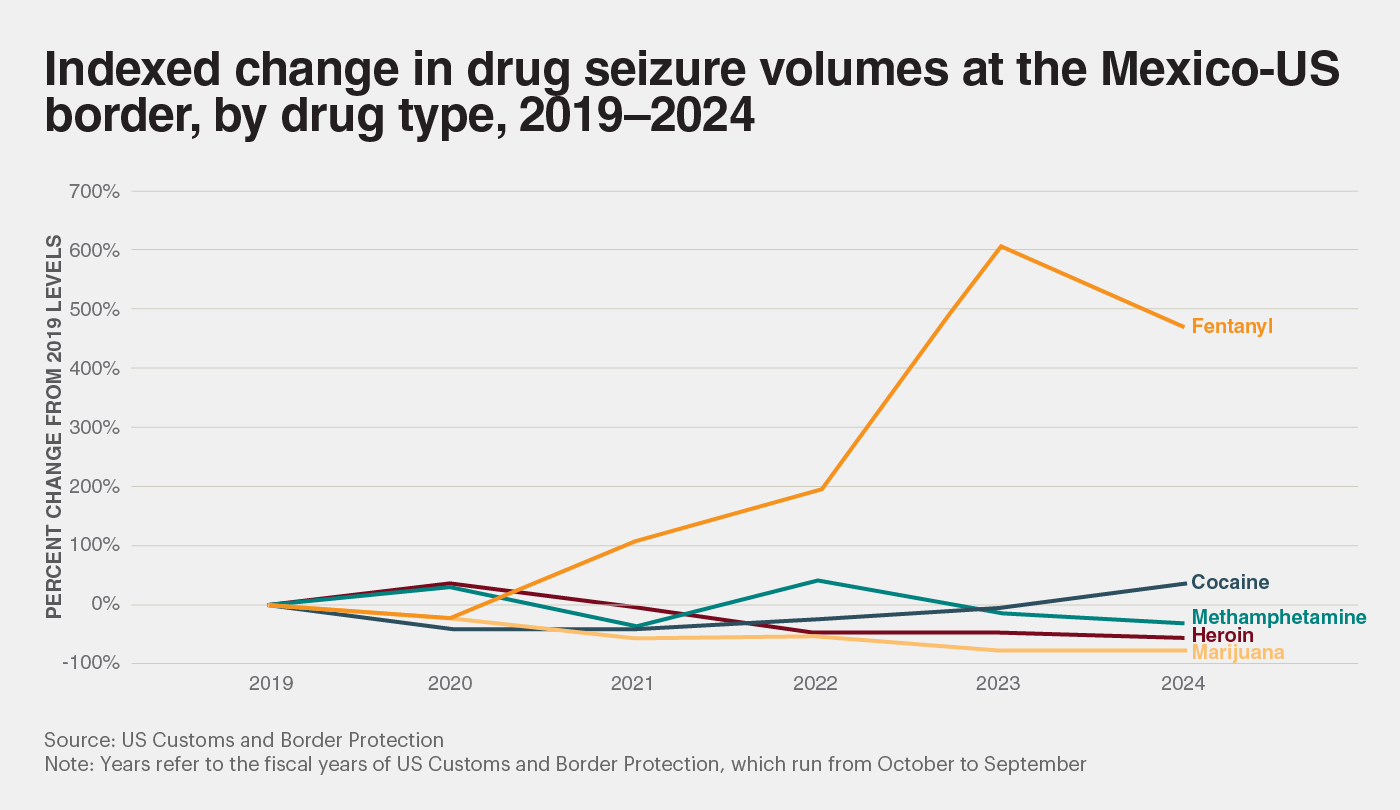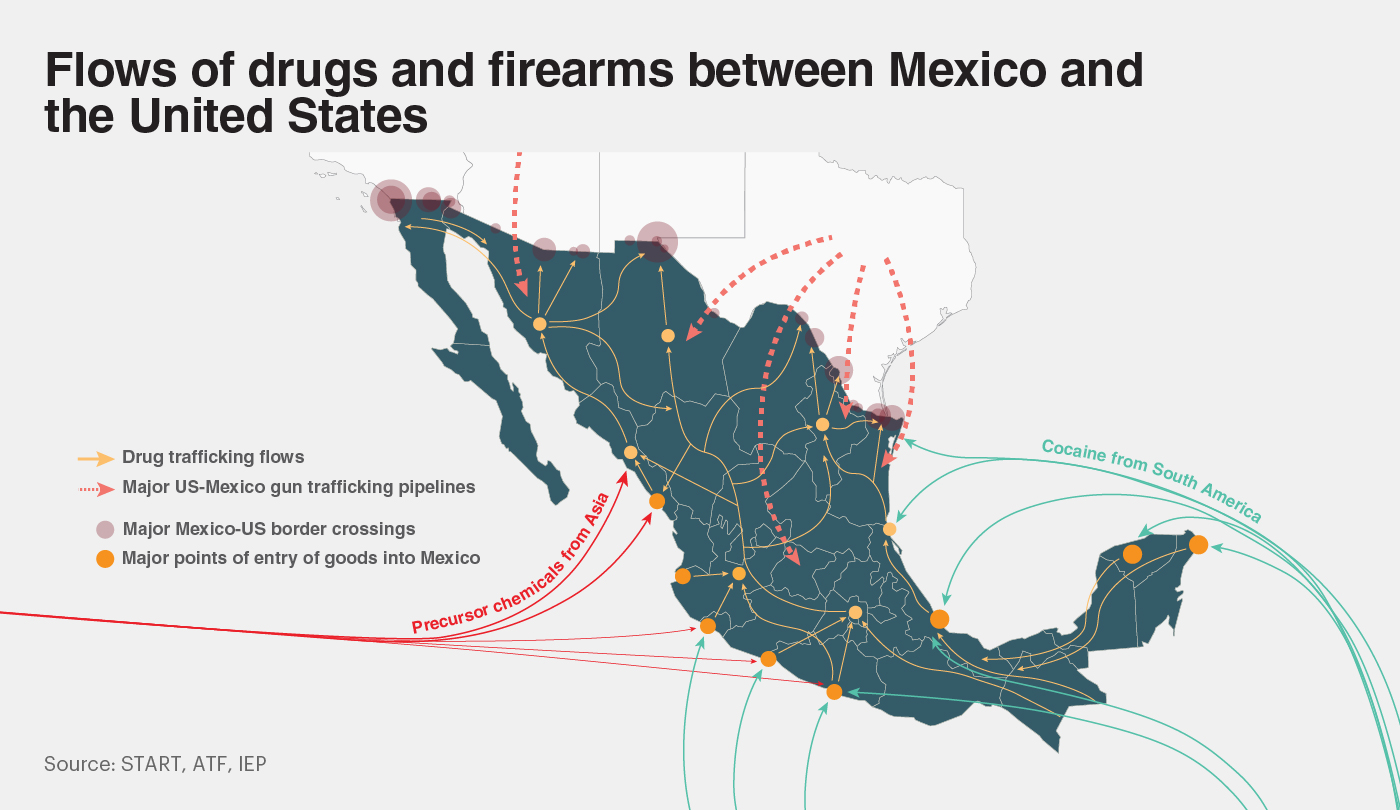In this year’s edition of the Mexico Peace Index 2025, we examine changes in drug trafficking organisations’ activities in response to shifts in the markets for illicit drugs in both the United States and Mexico. Historically, plant-based drugs such as marijuana and heroin were the main drugs trafficked across the Mexico-US border. In recent years, however, there has been a notable decline in the demand for these drugs, while the demand of synthetic drugs – particularly fentanyl – has surged.
This dramatic rise in fentanyl trafficking can be seen in the chart below, which shows the indexed change in the volume of drugs seized at the Mexico-US border since 2019.

The decreasing demand for marijuana from Mexico can be attributed to the legalisation and decriminalisation of marijuana in most US states, increasing the domestic accessibility. In 2013, when only a few US states had legalised the recreational use of marijuana, seizures along the Mexico-US border were just under 1,350 metric tons. By late 2024, with marijuana being unconditionally illegal in only one state, the volume of border seizures decreased to about 25.5 metric tons.
With marijuana’s massive decline in profitability, drug trafficking organisations have expanded their trafficking of other more lucrative drugs, with fentanyl being the most prevalent. As opposed to plant-based drugs that require land and can be sensitive to weather changes, synthetic drugs can be chemically produced in easy-to-hide small spaces.

The flow of fentanyl begins outside of Mexico, as the chemical precursors are primarily sourced from China. Mexican criminal organisations have increasingly exploited the legal wildlife trade between Mexico and China to facilitate illicit trade. These groups dominate domestic wildlife markets in Mexico and use wildlife products as a means of transferring value to Chinese traders, who, in turn, supply them with the necessary chemical precursors for fentanyl production.
The drug’s extreme potency and relatively cheap production costs make it highly profitable at a low volume. As a result, the markup of fentanyl can be as much as 2,700 times the price of production. It has been estimated that cartels profit between US$700 and US$1 billion annually from the fentanyl trade.
Synthetic narcotics like fentanyl are both highly addictive and lethal. Often presented in powder or pill form, these drugs can be consumed unknowingly when they are laced into other substances, such as counterfeit prescription medications. A study conducted in 2021-2022 tested 40 pharmacies in northern Mexico for laced and counterfeit drugs. Among their findings was that 63.7 per cent of samples sold as Adderall contained methamphetamine, and 29.6 per cent of samples sold as Oxycodone contained fentanyl.
Foreign tourists are particularly vulnerable to counterfeit drug sales, especially since many Americans seek the cheaper medical costs in Mexico. The US Drug Enforcement Administration states that just two milligrams of fentanyl can be lethal. With the increased flow and consumption of fentanyl, the number of drug overdose deaths in the US increased by sixfold between 2018 and 2023.
Despite the substantial increases in the consumption of fentanyl in the past decade, recent data suggests that the flow of fentanyl may have peaked in 2023. As seen in the figure above, following a 600 per cent increase between 2019 and 2023, the amount of fentanyl seized at the border decreased by 20 per cent in 2024. Additionally, last year was the first year on record to register a decline in overdoses involving the drug. Drug overdose deaths in the United States reached an all-time high of over 110,000 in 2023 but fell to around 87,000 last year. This drop was almost entirely the result of a substantial decline in deaths involving synthetic opioids, primarily fentanyl, which fell from around 81,000 deaths to around 59,000. Experts point out a variety of possible causes, including improved addiction healthcare, less potent fentanyl being sold, and that the high death rates in recent years have caused there to be a lower population of vulnerable people living with addiction.
However, within Mexico, late 2024 saw an upsurge of fentanyl seizures, as the daily average went from 4.4 kilograms between 2019 to September 2024 to 15.3 kilograms post September 2024. The largest seizure in Mexico’s history occurred in December 2024 when 1,100 kilograms of fentanyl, equivalent to 20 million doses and a market value of about US$400 million, was seized.
While Mexico has traditionally been seen as a producer and transit point for drugs destined for the United States, its internal drug market has been growing in recent years. The rate of retail drug crimes was the MPI organised crime sub-indicator to experience by far the largest increase over the past ten years and was the only sub-indicator to consistently rise each year since 2016. This trend reflects the increasing reliance of Mexican drug traffickers on sales to domestic consumers.
Data from the Mexican Observatory for Mental Health and Addictions reveals that substance abuse has risen in Mexico in the past decade. The number of people seeking treatment in the country for use of psychoactive substances rose from around 142,000 in 2015 to about 179,000 in 2023. As shown in the following figure, this increase has been driven by growing abuse of amphetamine-type stimulants, which include methamphetamine and ecstasy.

The number of people seeking treatment for these stimulants has risen more than fivefold since 2015. In contrast, the number of people seeking treatment for alcohol and marijuana, which used to be the most common categories, have fallen by 20.9 and 38.3 per cent, respectively. Moreover, while much less common overall, there has also been a dramatic rise in fentanyl abuse within Mexico. In 2015, there were just four recorded cases of individuals seeking treatment for fentanyl use, but by 2023 that number had risen to 518.
Like the United States, these trends suggest a shift within Mexico’s internal drug market toward synthetic drugs, primarily methamphetamine. The upsurge in synthetic drug consumption, both in Mexico and the US, has been driven by their extreme addictiveness; the ease with which they can be produced, transported, and sold; and their high profitability for organised crime groups.